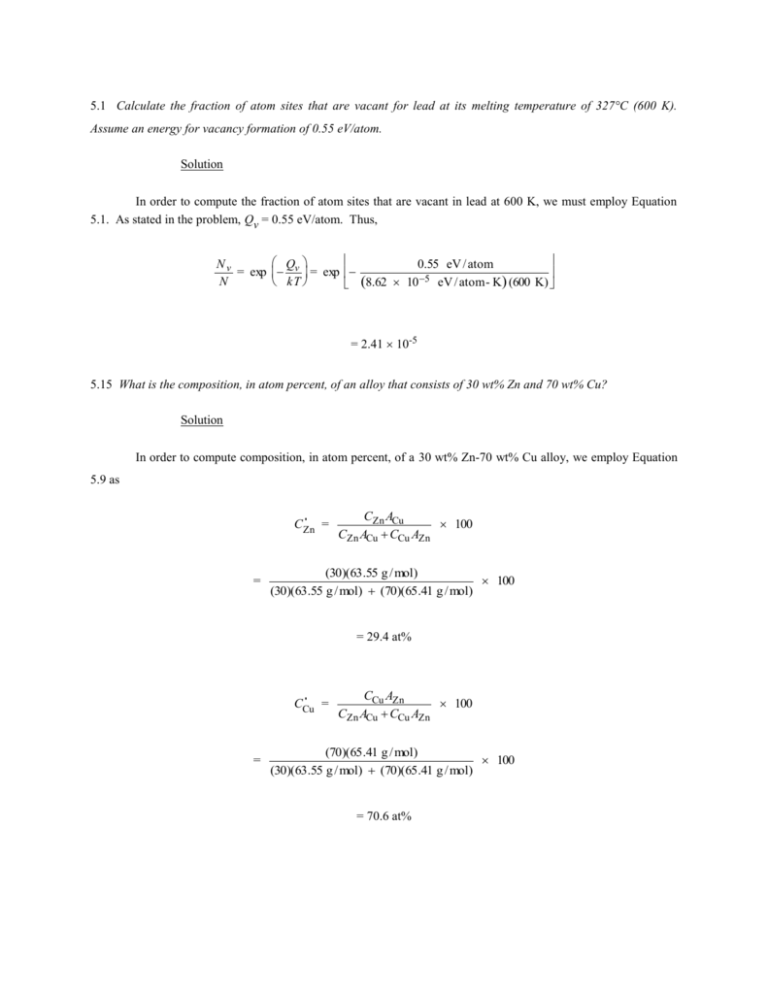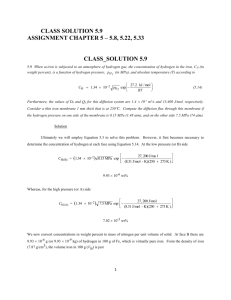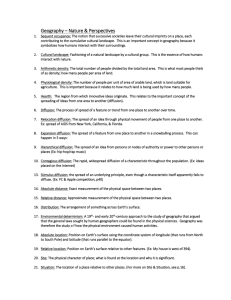5.1 Calculate the fraction of atom sites that are vacant for lead at its
advertisement

5.1 Calculate the fraction of atom sites that are vacant for lead at its melting temperature of 327°C (600 K). Assume an energy for vacancy formation of 0.55 eV/atom. Solution In order to compute the fraction of atom sites that are vacant in lead at 600 K, we must employ Equation 5.1. As stated in the problem, Qv = 0.55 eV/atom. Thus, Q Nv 0.55 eV / atom = exp v = exp kT N (8.62 10 5 eV / atom- K) (600 K) = 2.41 10-5 5.15 What is the composition, in atom percent, of an alloy that consists of 30 wt% Zn and 70 wt% Cu? Solution In order to compute composition, in atom percent, of a 30 wt% Zn-70 wt% Cu alloy, we employ Equation 5.9 as ' CZn = = (30)(63.55 g / mol) 100 (30)(63.55 g / mol) (70)(65.41 g / mol) = 29.4 at% ' CCu = CZn ACu 100 CZn ACu CCu AZn = CCu AZn 100 CZn ACu CCu AZn (70)(65.41 g / mol) 100 (30)(63.55 g / mol) (70)(65.41 g / mol) = 70.6 at% 5.34 Cite the relative Burgers vector–dislocation line orientations for edge, screw, and mixed dislocations. Solution The Burgers vector and dislocation line are perpendicular for edge dislocations, parallel for screw dislocations, and neither perpendicular nor parallel for mixed dislocations. 5.37 (a) For a given material, would you expect the surface energy to be greater than, the same as, or less than the grain boundary energy? Why? (b) The grain boundary energy of a small-angle grain boundary is less than for a high-angle one. Why is this so? Solution (a) The surface energy will be greater than the grain boundary energy. For grain boundaries, some atoms on one side of a boundary will bond to atoms on the other side; such is not the case for surface atoms. Therefore, there will be fewer unsatisfied bonds along a grain boundary. (b) The small-angle grain boundary energy is lower than for a high-angle one because more atoms bond across the boundary for the small-angle, and, thus, there are fewer unsatisfied bonds. 5.38 (a) Briefly describe a twin and a twin boundary. (b) Cite the difference between mechanical and annealing twins. Solution (a) A twin boundary is an interface such that atoms on one side are located at mirror image positions of those atoms situated on the other boundary side. The region on one side of this boundary is called a twin. (b) Mechanical twins are produced as a result of mechanical deformation and generally occur in BCC and HCP metals. Annealing twins form during annealing heat treatments, most often in FCC metals. 6.1 Briefly explain the difference between self-diffusion and interdiffusion. Solution Self-diffusion is atomic migration in pure metals--i.e., when all atoms exchanging positions are of the same type. Interdiffusion is diffusion of atoms of one metal into another metal. 6.2 Self-diffusion involves the motion of atoms that are all of the same type; therefore, it is not subject to observation by compositional changes, as with interdiffusion. Suggest one way in which self-diffusion may be monitored. Solution Self-diffusion may be monitored by using radioactive isotopes of the metal being studied. The motion of these isotopic atoms may be monitored by measurement of radioactivity level. Diffusion Mechanisms 6.3 (a) Compare interstitial and vacancy atomic mechanisms for diffusion. (b) Cite two reasons why interstitial diffusion is normally more rapid than vacancy diffusion. Solution (a) With vacancy diffusion, atomic motion is from one lattice site to an adjacent vacancy. Self-diffusion and the diffusion of substitutional impurities proceed via this mechanism. On the other hand, atomic motion is from interstitial site to adjacent interstitial site for the interstitial diffusion mechanism. (b) Interstitial diffusion is normally more rapid than vacancy diffusion because: (1) interstitial atoms, being smaller, are more mobile; and (2) the probability of an empty adjacent interstitial site is greater than for a vacancy adjacent to a host (or substitutional impurity) atom. Steady-State Diffusion 6.4 Briefly explain the concept of steady state as it applies to diffusion. Solution Steady-state diffusion is the situation wherein the rate of diffusion into a given system is just equal to the rate of diffusion out, such that there is no net accumulation or depletion of diffusing species--i.e., the diffusion flux is independent of time. 6.5 (a) Briefly explain the concept of a driving force. (b) What is the driving force for steady-state diffusion? Solution (a) The driving force is that which compels a reaction to occur. (b) The driving force for steady-state diffusion is the concentration gradient. 6.8 A sheet of BCC iron 1 mm thick was exposed to a carburizing gas atmosphere on one side and a decarburizing atmosphere on the other side at 725C. After having reached steady state, the iron was quickly cooled to room temperature. The carbon concentrations at the two surfaces of the sheet were determined to be 0.012 and 0.0075 wt%, respectively. Compute the diffusion coefficient if the diffusion flux is 1.4 10-8 kg/m2-s. Hint: Use Equation 5.12 to convert the concentrations from weight percent to kilograms of carbon per cubic meter of iron. Solution Let us first convert the carbon concentrations from weight percent to kilograms carbon per meter cubed using Equation 5.12a. For 0.012 wt% C CC" = CC CC C = CFe 10 3 Fe 0.012 10 3 0.012 99.988 2.25 g/cm3 7.87 g/cm3 0.944 kg C/m3 Similarly, for 0.0075 wt% C CC" = 0.0075 0.0075 99.9925 2.25 g/cm3 7.87 g/cm 3 10 3 = 0.590 kg C/m3 Now, using a rearranged form of Equation 6.3 x x B D = J A C C A B 10 3 m 10 -8 kg/m 2 - s) = (1.40 3 3 0.944 kg/m 0.590 kg/m = 3.95 10-11 m2/s 6.9 When -iron is subjected to an atmosphere of hydrogen gas, the concentration of hydrogen in the iron, CH (in weight percent), is a function of hydrogen pressure, pH 2 (in MPa), and absolute temperature (T) according to 27.2 kJ / mol CH 1.34 10 2 pH 2 exp RT (6.16) Furthermore, the values of D0 and Qd for this diffusion system are 1.4 10-7 m2/s and 13,400 J/mol, respectively. Consider a thin iron membrane 1 mm thick that is at 250 C. Compute the diffusion flux through this membrane if the hydrogen pressure on one side of the membrane is 0.15 MPa (1.48 atm) and that on the other side is 7.5 MPa (74 atm). Solution Ultimately we will employ Equation 6.3 to solve this problem. However, it first becomes necessary to determine the concentration of hydrogen at each face using Equation 6.16. At the low pressure (or B) side 27, 200 J/mo l CH(B) = (1.34 10 -2) 0.15 MPa exp (8.31 J/mol - K)(250 273 K ) 9.93 10-6 wt% Whereas, for the high pressure (or A) side 27, 200 J/mol CH(A) = (1.34 10 -2 ) 7.5 MPa exp (8.31 J/mol - K)(250 273 K ) 7.02 10-5 wt% We now convert concentrations in weight percent to mass of nitrogen per unit volume of solid. At face B there are 9.93 10-6 g (or 9.93 10-9 kg) of hydrogen in 100 g of Fe, which is virtually pure iron. From the density of iron (7.87 g/cm3), the volume iron in 100 g (V ) is just B VB = 100 g 7.87 g /cm3 = 12.7 cm 3 = 1.27 10 -5 m 3 ’’ Therefore, the concentration of hydrogen at the B face in kilograms of H per cubic meter of alloy [ CH(B) ] is just '' CH(B) = = CH(B) VB 9.93 109 kg = 7.82 10 -4 kg/m3 1.27 105 m3 At the A face the volume of iron in 100 g (VA) will also be 1.27 10-5 m3, and '' CH(A) = = CH(A) VA 7.02 108 kg = 5.53 10 -3 kg/m3 1.27 105 m3 Thus, the concentration gradient is just the difference between these concentrations of nitrogen divided by the thickness of the iron membrane; that is '' '' CH(B) CH(A) C = x xB xA = 7.82 104 kg / m3 5.53 103 kg / m3 = 4.75 kg/m4 103 m At this time it becomes necessary to calculate the value of the diffusion coefficient at 250C using Equation 6.8. Thus, Q D = D0 exp d RT 13,400 J/mol 7 2 = (1.4 10 m /s) exp (8.31 J/mol K)(250 273 K) = 6.41 10-9 m2/s And, finally, the diffusion flux is computed using Equation 6.3 by taking the negative product of this diffusion coefficient and the concentration gradient, as J =D C x = (6.41 10 -9 m2/s)( 4.75 kg/m4 ) = 3.05 10 -8 kg/m2 - s Nonsteady-State Diffusion 6.11 Determine the carburizing time necessary to achieve a carbon concentration of 0.45 wt% at a position 2 mm into an iron–carbon alloy that initially contains 0.20 wt% C. The surface concentration is to be maintained at 1.30 wt% C, and the treatment is to be conducted at 1000C. Use the diffusion data for -Fe in Table 6.2. Solution In order to solve this problem it is first necessary to use Equation 6.5: C x C0 x = 1 erf 2 Dt Cs C0 wherein, Cx = 0.45, C0 = 0.20, Cs = 1.30, and x = 2 mm = 2 10-3 m. Thus, x Cx C0 0.45 0.20 = = 0.2273 = 1 erf 2 Dt Cs C0 1.30 0.20 or x erf = 1 0.2273 = 0.7727 2 Dt By linear interpolation using data from Table 6.1 z erf(z) 0.85 0.7707 z 0.7727 0.90 0.7970 z 0.850 0.7727 0.7707 = 0.900 0.850 0.7970 0.7707 From which z = 0.854 = x 2 Dt Now, from Table 6.2, at 1000C (1273 K) 148,000 J/mol D = (2.3 10 -5 m 2 /s) exp (8.31 J/mol - K)(1273 K) = 1.93 10-11 m2/s Thus, 0.854 = Solving for t yields 2 10 3 m (2) (1.93 10 11 m2 /s) (t) t = 7.1 104 s = 19.7 h 6.12 An FCC iron-carbon alloy initially containing 0.35 wt% C is exposed to an oxygen-rich and virtually carbon-free atmosphere at 1400 K (1127C). Under these circumstances the carbon diffuses from the alloy and reacts at the surface with the oxygen in the atmosphere; that is, the carbon concentration at the surface position is maintained essentially at 0 wt% C. (This process of carbon depletion is termed decarburization.) At what position will the carbon concentration be 0.15 wt% after a 10-h treatment? The value of D at 1400 K is 6.9 10-11 m2/s. Solution This problem asks that we determine the position at which the carbon concentration is 0.15 wt% after a 10h heat treatment at 1325 K when C0 = 0.35 wt% C. From Equation 6.5 x Cx C0 0.15 0.35 = = 0.5714 = 1 erf 2 Dt Cs C0 0 0.35 Thus, x erf = 0.4286 2 Dt Using data in Table 6.1 and linear interpolation z erf (z) 0.40 0.4284 z 0.4286 0.45 0.4755 z 0.40 0.4286 0.4284 = 0.45 0.40 0.4755 0.4284 And, z = 0.4002 Which means that x = 0.4002 2 Dt And, finally x = 2(0.4002) Dt = (0.8004) (6.9 1011 m2/s)( 3.6 104 s) = 1.26 10-3 m = 1.26 mm 6.16 Cite the values of the diffusion coefficients for the interdiffusion of carbon in both α-iron (BCC) and γ-iron (FCC) at 900°C. Which is larger? Explain why this is the case. Solution We are asked to compute the diffusion coefficients of C in both and iron at 900C. Using the data in Table 6.2, 80,000 J/mol D = (6.2 10 -7 m2 /s) exp (8.31 J/mol - K)(1173 K) = 1.69 10-10 m2/s 148,000 J/mol D = (2.3 10 -5 m2 /s) exp (8.31 J/mol - K)(1173 K) = 5.86 10-12 m2/s The D for diffusion of C in BCC iron is larger, the reason being that the atomic packing factor is smaller than for FCC iron (0.68 versus 0.74—Section 3.4); this means that there is slightly more interstitial void space in the BCC Fe, and, therefore, the motion of the interstitial carbon atoms occurs more easily. 6.17 Using the data in Table 6.2, compute the value of D for the diffusion of zinc in copper at 650ºC. Solution Incorporating the appropriate data from Table 6.2 into Equation 6.8 leads to 189,000 J/mol D = (2.4 10 -5 m2 /s) exp (8.31 J/mol - K)(650 273 K) = 4.8 10-16 m2/s









